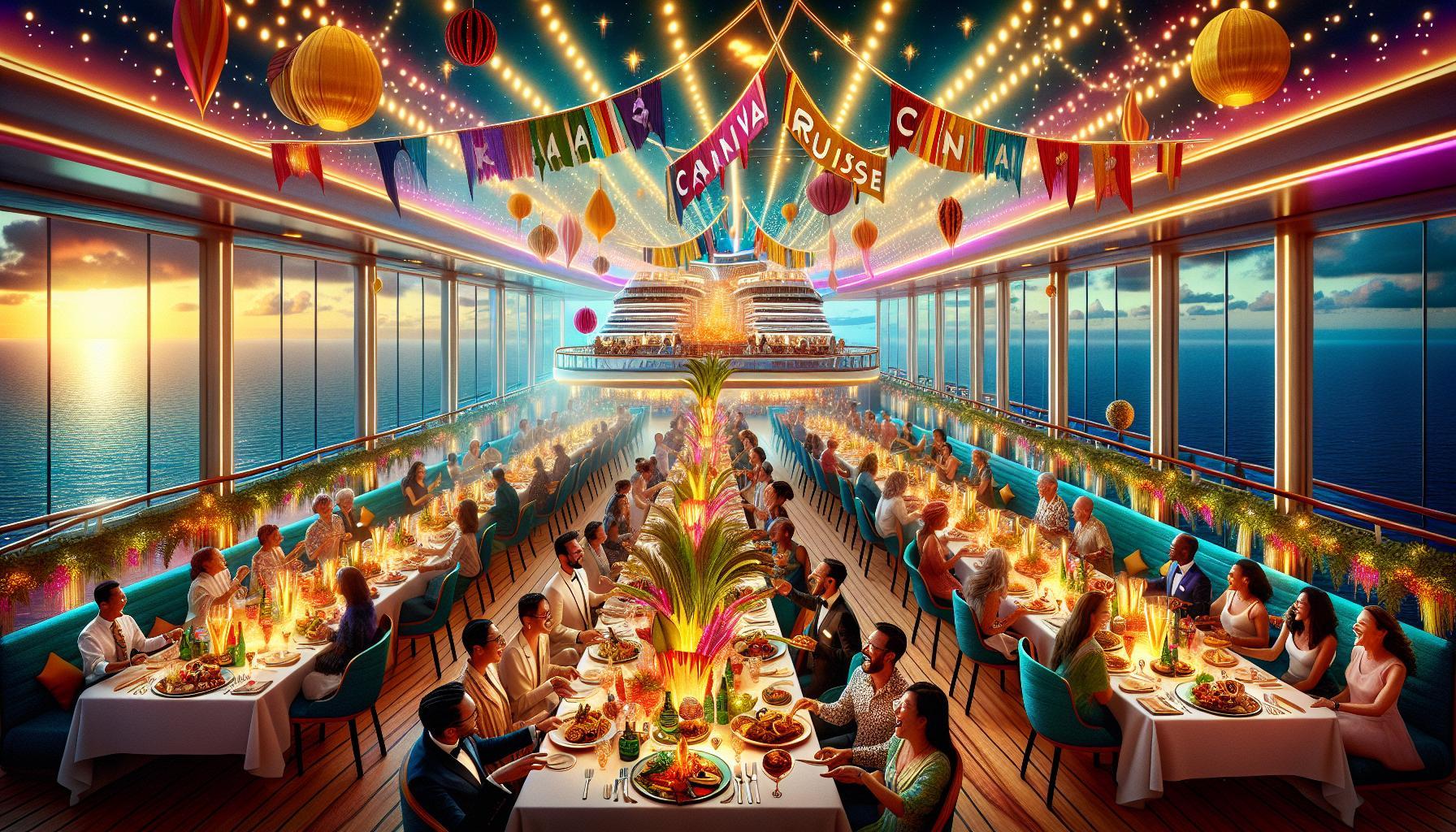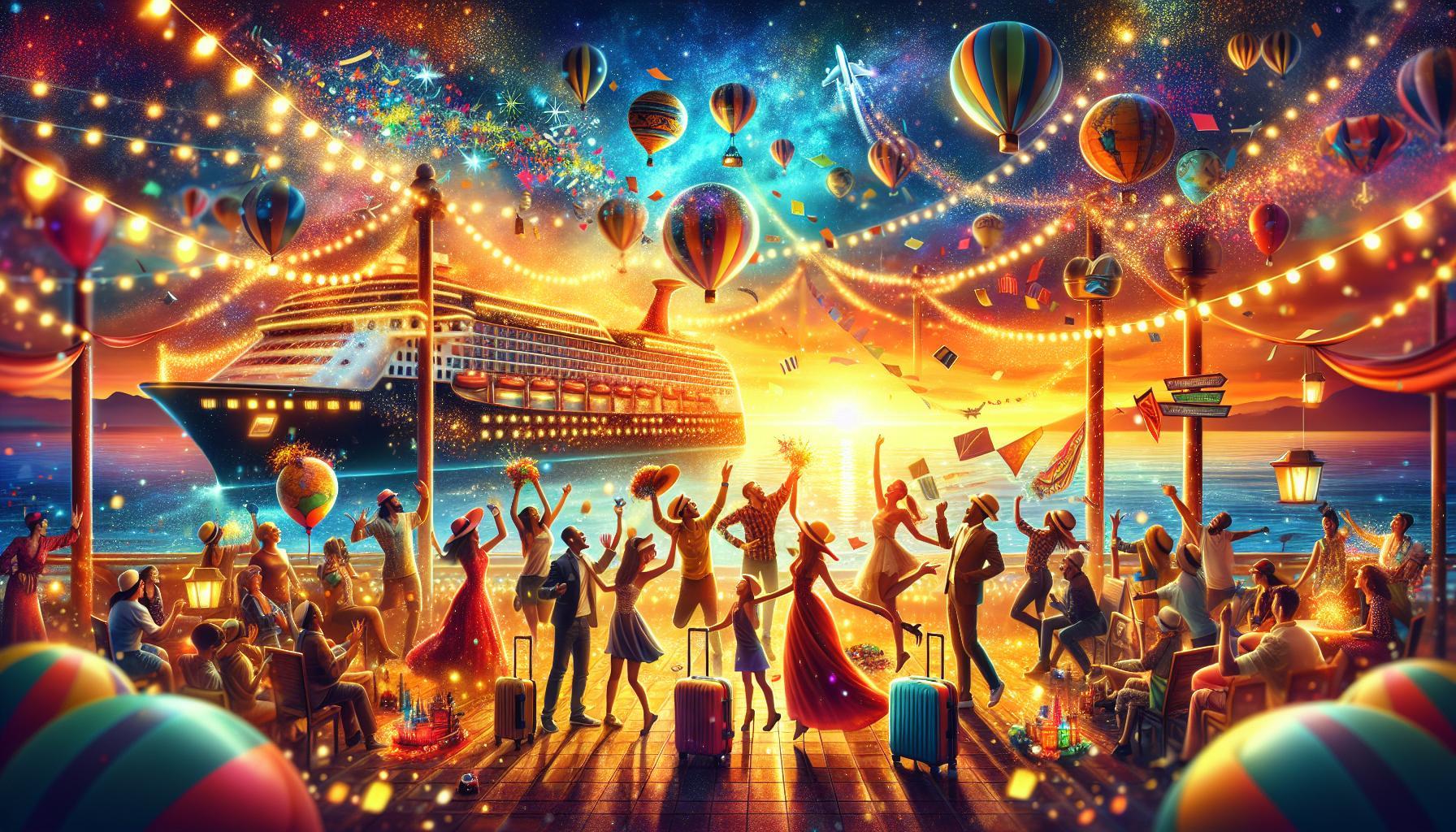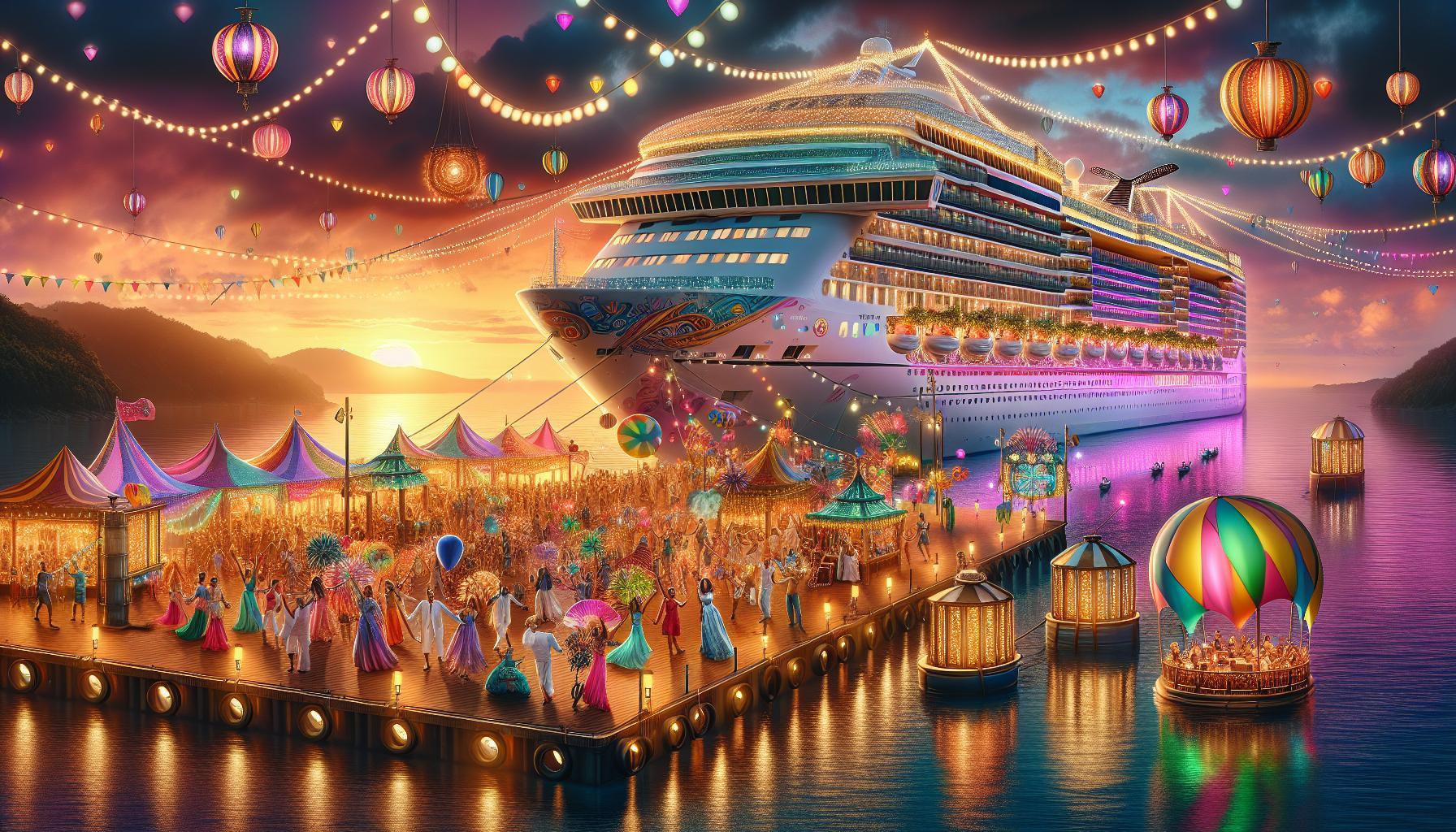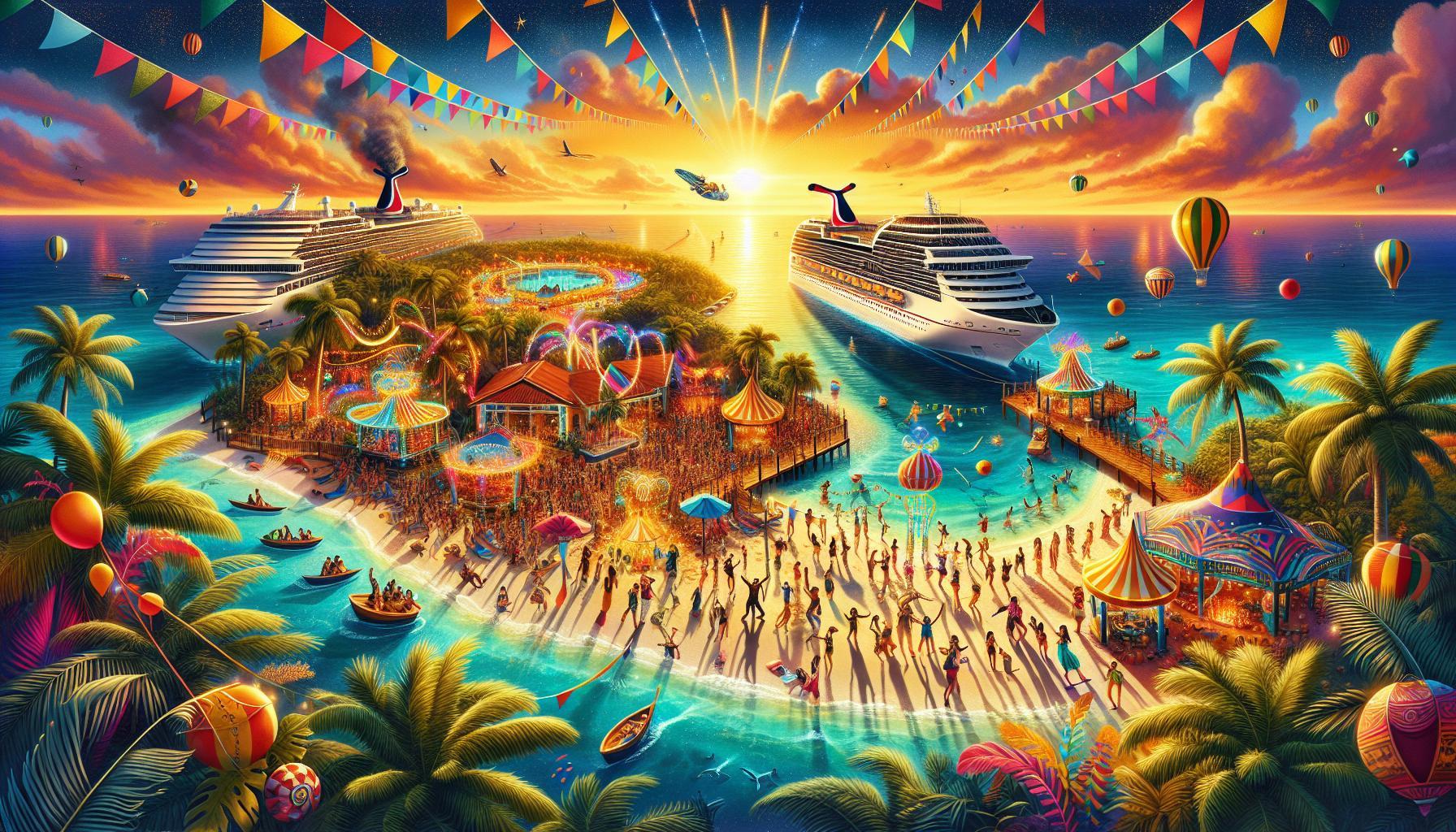Have you ever wondered about the safety of your dream vacation on the high seas? With increasing scrutiny on maritime safety, it’s crucial to explore the historical data and facts surrounding Carnival cruise ships. Delve into whether these vessels have ever faced the ultimate disaster of sinking and what measures are taken to ensure passenger safety.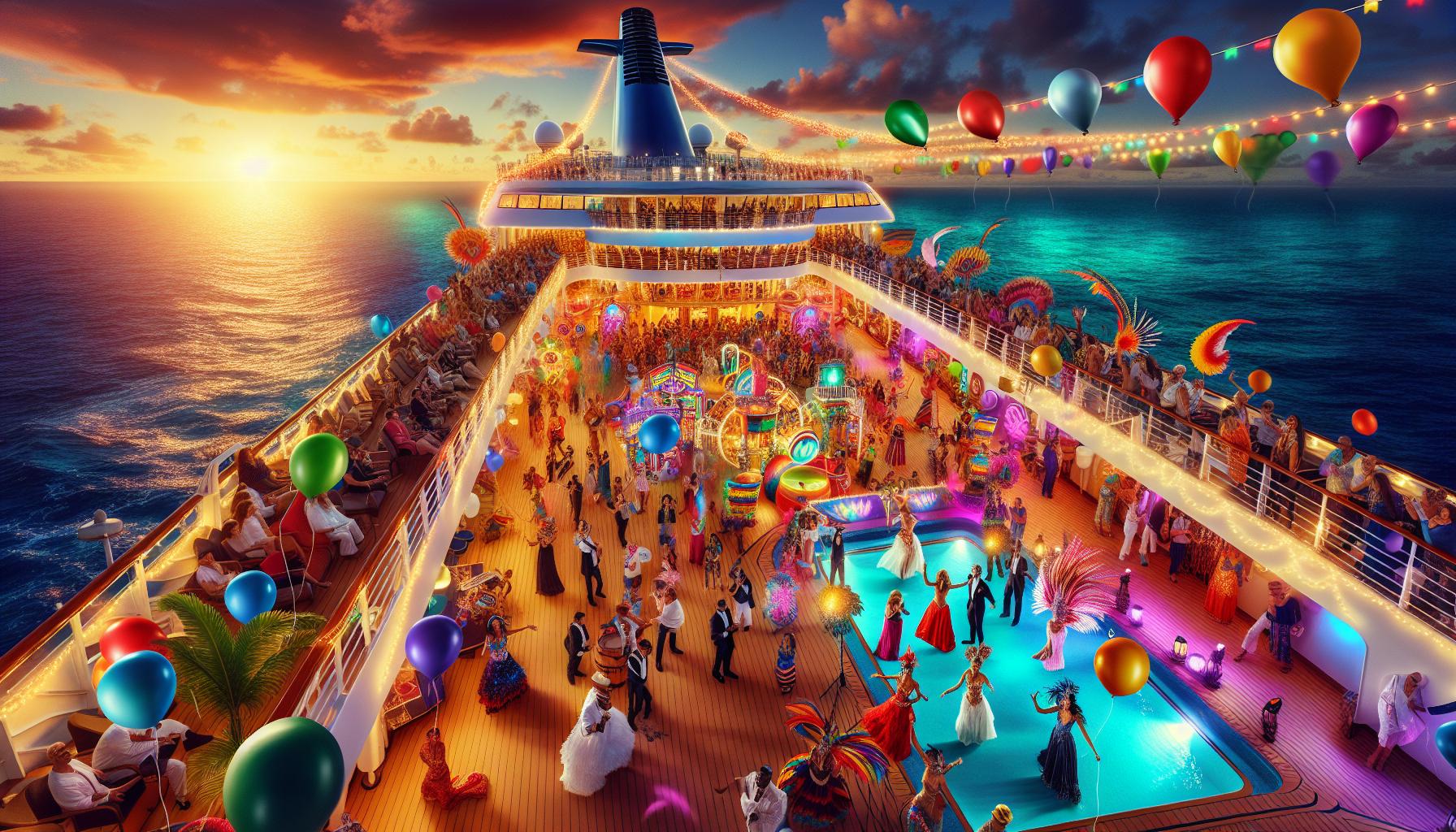
The Unforgettable Journey: Understanding Carnival Cruises and Their Safety Evolution
From the breathtaking views of the open sea to the exhilarating activities aboard its ships, Carnival Cruises offers guests an unforgettable journey filled with adventure and relaxation. However, like any mode of transportation, safety is a paramount concern, and the evolution of cruise safety has been substantial over the years. While the question of whether a Carnival cruise ship has ever sunk often arises, it is more essential to understand the robust safety measures in place today that prioritize passenger well-being.
The early days of cruising experienced various challenges, leading to significant advancements in maritime safety protocols. Following incidents that gained global attention, including notable events affecting cruise lines, Carnival has made continuous improvements to its safety systems. This includes enhancements in training for crew members, improved emergency protocols, and updated ship design features that enhance stability and safety. Today, Carnival conducts rigorous drills to ensure all crew members are prepared for any situation, enhancing the confidence of passengers.
Key Safety Features of Carnival Cruises
Carnival Cruises implements several key safety features that exemplify its commitment to passenger safety:
- Advanced Navigation Technologies: Modern ships are equipped with state-of-the-art navigation systems that help avoid potential hazards.
- Safety Drill Requirements: Passengers are required to participate in safety drills before embarking, ensuring everyone knows evacuation procedures.
- Onboard Medical Facilities: Each ship includes medical staff and facilities capable of handling emergencies, providing peace of mind while at sea.
- Regular Safety Audits: Carnival participates in routine audits to ensure adherence to international safety standards.
Despite concerns raised in historical narratives about cruise safety, statistics show that modern cruise vacations are remarkably secure. Passenger safety incidents are exceedingly rare, and the data indicates that cruising remains one of the safest ways to travel. The continuous commitment to safety and improvements in technology not only aim to prevent accidents but also ensure rapid responses when issues arise. Information regarding these advancements and their impacts can shed light on why the question “Has a Carnival Cruise Ship Ever Sunk?” is answered with a resounding emphasis on the line’s dedication to safe cruising environments.
Ultimately, understanding the evolution of safety measures in Carnival Cruises equips travelers with the knowledge that their experience, while it promises enjoyment and adventure, is also backed by a robust framework designed to protect them throughout their voyage. As advancements continue to develop, the journey aboard a Carnival cruise will remain not just an escape but a secure experience.
High Seas Adventures: A Look at Carnival Cruise Ship Incidents Through the Years
Carnival Cruise Line represents one of the largest and most popular cruise operators in the world, but like all maritime ventures, it has encountered its share of unexpected incidents. From mechanical failures to unfortunate accidents, these events have tested the resilience of both the crew and passengers. One might wonder, has a Carnival cruise ship ever sunk? While the answer remains a reassuring ‘no,’ the history of Carnival cruise ships includes numerous incidents that have drawn attention.
Notable Incidents Over the Years
Throughout its journey, Carnival Cruise Line has faced challenges that have raised questions about safety at sea. Here are several notable incidents that stand out:
- Carnival Triumph (2013): After a fire in the engine room, this ship became adrift for days in the Gulf of Mexico. Passengers experienced limited amenities and sanitation issues before being rescued.
- Carnival Elation (1998): A propeller malfunction resulted in the ship losing power while navigating through rough seas, leaving guests anxious about safety measures.
- Carnival Dream (2019): A mid-Atlantic power failure led to emergency procedures being enacted, and although it was efficiently managed, it reminded passengers of the potential unpredictability of sea travel.
Each of these incidents, while serious, illustrates the response protocols most cruise lines have developed over the years. Safety drills, strict adherence to emergency procedures, and well-trained crews serve as the backbone of cruise safety.
Incident Response Protocols
To better understand how Carnival Cruise Line handles emergencies, it is essential to view their response strategies. Potential issues aboard a cruise ship can range from minor technical difficulties to major emergencies during a voyage.
| Incident Type | Response Measures | Lessons Learned |
|---|---|---|
| Engine Failure | Backup generators and safety drills are activated. | Regular maintenance and checks are crucial. |
| Fire | Immediate evacuation procedures and fire containment measures are deployed. | Importance of fire safety training for crew and drills for guests. |
| Severe Weather | Adjusting routes to avoid storms and ensuring all guests are informed. | Proactive communication enhances guest confidence and safety. |
Travelers can feel more secure by being aware of how to react in various scenarios. Review safety instructions upon boarding, participate in safety drills, and stay informed of any updates from the crew during the voyage. This knowledge can enhance your overall cruising experience while keeping you prepared for the unexpected.
By recognizing the past challenges, prospective travelers can appreciate Carnival Cruise Line’s ongoing commitment to maintaining passenger safety and the extensive protocols that are a vital part of their operational philosophy. With an impressive track record of safety, the question might not just be whether a Carnival cruise ship has ever sunk, but rather how the industry continues to improve safety measures for all voyagers.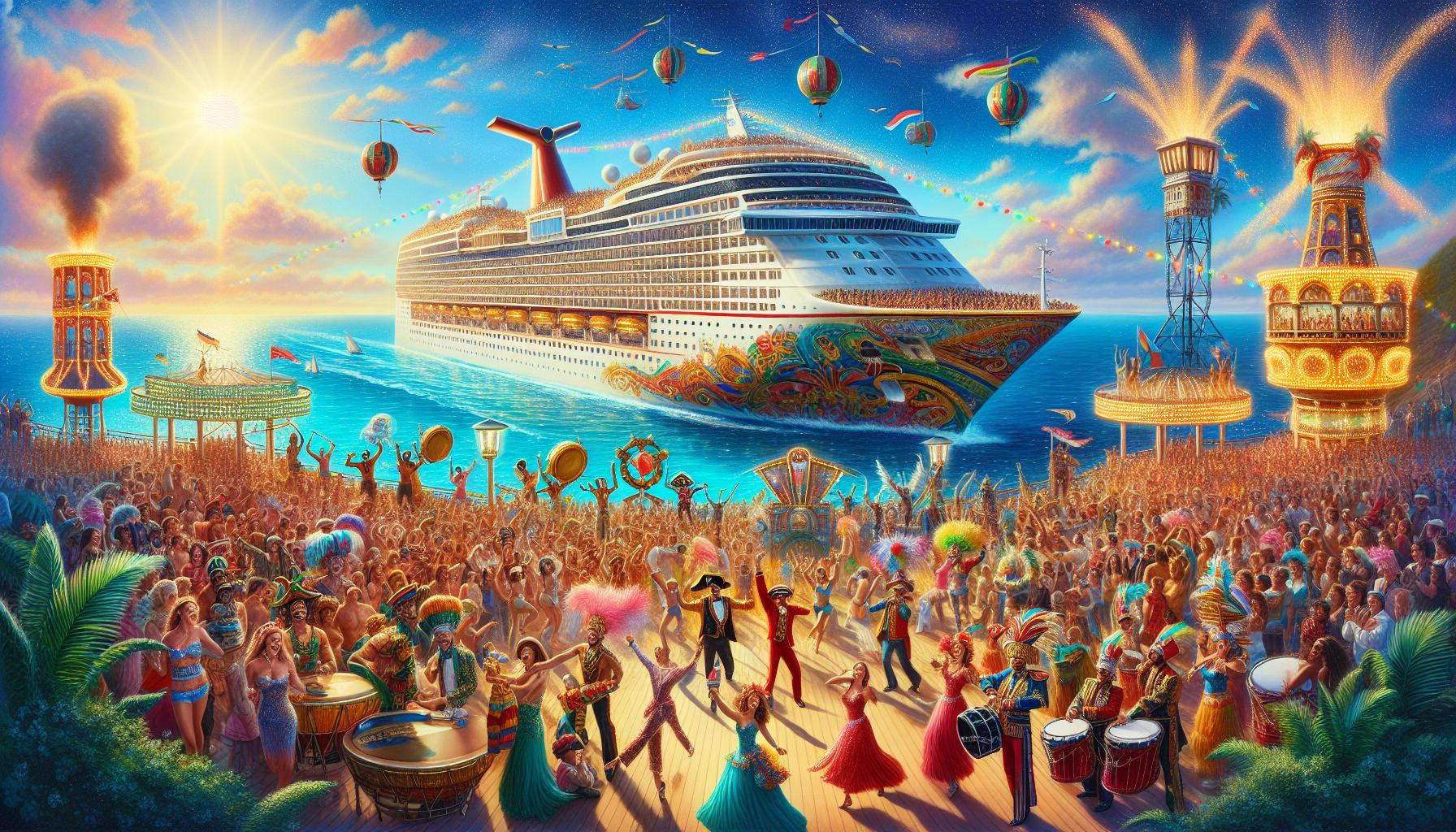
Behind the Scenes: How Carnival Ensures Safety on the Open Water
Ensuring passenger safety is paramount for cruise lines, particularly those like Carnival that operate in the vast and unpredictable open waters. While the idea of a cruise ship sinking is alarming, it’s essential to recognize the rigorous measures that companies employ to mitigate risks and protect their guests. A significant aspect of Carnival’s commitment to safety lies in its multifaceted approach, encompassing state-of-the-art technology, well-trained personnel, and comprehensive emergency protocols.
State-of-the-Art Technology
Carnival employs a variety of advanced technologies to enhance safety onboard. These include:
- Real-time Weather Monitoring: Utilizing sophisticated meteorological tools, ships can receive timely updates about weather conditions, allowing for route adjustments when necessary.
- Advanced Navigation Systems: Equipped with GPS and other navigation aids, cruise ships are designed to avoid hazards and ensure safe passages.
- Integrated Safety Management Systems: This includes alarms, sensors, and communication systems that work together to detect potential issues before they escalate.
Trained Personnel and Safety Drills
The crew plays a vital role in maintaining safety at sea. Each crew member undergoes rigorous training that includes extensive safety drills designed to prepare them for emergencies.
- Regular Emergency Drills: Passengers participate in mandatory muster drills before departure, ensuring everyone knows the procedures in case of an emergency.
- Ongoing Training: Crew members receive continuous education on emergency response, first aid, and fire safety to keep their skills sharp.
- Emergency Response Teams: Specialized teams trained to handle specific scenarios quickly and efficiently help ensure calm and effective responses during any incident.
Comprehensive Safety Protocols
Carnival has established a robust set of safety protocols that encompass everything from embarkation to disembarkation:
| Safety Protocol | Description |
|---|---|
| Safety Equipment Checks | Regular inspections of life jackets, lifeboats, and fire safety equipment. |
| Passenger Awareness Programs | Educational materials provided to guests regarding safety procedures and guidelines. |
| Emergency Evacuation Plans | Detailed plans outlining specific actions in case of fire, flooding, or other emergencies. |
| Collaboration with Regulatory Bodies | Adherence to guidelines set by international maritime agencies to guarantee compliance with safety standards. |
Through these comprehensive safety measures, coupled with continuous advancements in cruise safety protocols, Carnival effectively minimizes the risks associated with travel on water. Although inquiries such as “Has a Carnival Cruise Ship Ever Sunk? Cruise Safety Facts Revealed” arise due to public interest, Carnival’s commitment to safety is your assurance that every journey is a well-planned experience in cruising safety.
Real Stories: The Cases of Cruise Ships Overcoming Disaster
The ocean is an unpredictable beast, and while concerns about maritime safety can sometimes overshadow the joys of cruising, there are numerous real-life stories of cruise ships navigating through treacherous waters and overcoming imminent disaster. One of the most profound examples involves the Carnival Cruise Line itself, showcasing remarkable resilience and safety practices that highlight the robustness of modern maritime operations.
Triumph Against Adversity
Take, for instance, the story of the Carnival Triumph in February 2013, which faced a severe engine room fire that resulted in a loss of power. Stranded in the Gulf of Mexico, the ship’s situation was dire, with passengers left without power, running water, or sufficient sanitation. What could have ended in disaster turned into a testament of effective crisis management and onboard teamwork. The crew swiftly ensured passenger safety by implementing emergency protocols, and rescue operations were coordinated efficiently. The ship was towed to shore, where passengers were met with medical care and support.
A Lesson in Preparedness
This instance underscores the importance of preparedness within the cruise industry. The Carnival Triumph incident prompted Carnival Cruise Line to enhance safety measures across all fleets. Following the event, the company increased investment in crew training and ship maintenance, promoting a culture of safety. They incorporated regular emergency drills, which not only equip the crew to handle crises but also create a sense of security among passengers.
- Regular Emergency Drills: Passengers are encouraged to participate in safety drills upon boarding.
- Upgraded Technology: Ships now feature advanced monitoring systems for engine and safety equipment.
- Robust Training Programs: Crew members undergo extensive training to manage onboard emergencies efficiently.
Additional Success Stories
Moreover, the story of the Costa Allegra further illustrates the capability of cruise lines to navigate adversity. In February 2012, the ship lost power in the Indian Ocean due to a fire. The crew’s exemplary response involved swiftly moving passengers to safe areas and maintaining communication with maritime authorities. Rescue ships were sent, and within days, all passengers were safely evacuated without serious injury.
| Incident | Outcome | Safety Measures Implemented |
|---|---|---|
| Carnival Triumph Fire | All passengers safely evacuated; no major injuries reported. | Enhanced training programs and safety drills. |
| Costa Allegra Fire | Rescue completed; no casualties. | Strong crew communication protocols; upgraded emergency response strategies. |
These cases exemplify that while the question, “Has a Carnival Cruise Ship Ever Sunk? Cruise Safety Facts Revealed,” may linger in the minds of many, the cruise industry is implementing changes and contingencies to enhance passenger safety. By understanding these stories, prospective cruisers can appreciate not only the thrill of exploration but the robust measures in place, making modern cruising a safe adventure for all.
Setting Sail with Confidence: Essential Safety Tips for First-Time Travelers
As you prepare for your first cruise, it’s essential to know that safety measures have significantly evolved over the years. The question “Has a Carnival Cruise Ship Ever Sunk?” often lingers in the minds of first-time travelers, but it’s crucial to understand that modern cruise ships are equipped with numerous safety features designed to prevent incidents at sea. By embracing some practical safety tips, you can set sail with confidence, knowing you’re prepared for anything the ocean may toss your way.
Essential Safety Measures to Keep in Mind
Before embarking on your maritime adventure, familiarize yourself with the ship’s safety protocols. Most cruise lines, including Carnival, conduct safety drills as part of their boarding procedures. Pay close attention during these drills; they provide vital information on life jacket usage, evacuation routes, and emergency signals. Here are some key safety practices:
- Stay Informed: Read through the cruise safety guidelines provided in your cabin and pay attention during the safety orientation.
- Know Your Muster Station: Identify your muster station (the designated meeting point) so you can reach it quickly if needed.
- Follow Crew Instructions: Always trust the crew’s expertise during emergencies; they are trained to handle various situations and keep passengers safe.
- Emergency Contacts: Familiarize yourself with the emergency contacts and procedures available on board.
Smart Packing: Be Prepared on Your Journey
Being well-prepared can make all the difference in your comfort and safety while cruising. Here’s a mini-guide to help with your packing list:
| Item | Purpose |
|---|---|
| Life Jacket | Utilize the ship-supplied life jackets during safety drills and ensure they fit properly. |
| First Aid Kit | For minor injuries or ailments, having a basic first aid kit can be a lifesaver. |
| Medications | Bring any prescriptions and seasickness medication, as onboard pharmacies may be limited. |
| Emergency Whistle | A small whistle can help signal for assistance in case you’re far from others. |
Taking the extra step to pack smartly not only enhances your personal safety but also contributes to the overall emergency readiness of your travel experience. While the question of “Has a Carnival Cruise Ship Ever Sunk?” highlights the concerns about safety, the reality is that being informed and prepared equips first-time travelers to enjoy a memorable and safe voyage. Enjoy your cruise, knowing you are well-equipped for whatever lies ahead!
The Role of Technology in Modern Cruise Safety
In the ever-evolving landscape of maritime travel, technology has become a cornerstone for ensuring passenger safety on cruise ships. With advancements in engineering, navigation, and communication systems, modern vessels are better equipped than ever to prevent accidents and respond effectively in emergencies. As we delve into the intricacies of cruise safety, it’s essential to recognize how technology has dramatically altered the protocols and equipment aboard ships, making incidents like those investigated in “Has a Carnival Cruise Ship Ever Sunk? Cruise Safety Facts Revealed” exceedingly rare.
Innovative Safety Features
Cruise ships today are outfitted with an array of innovative safety features designed to enhance passenger protection. Some notable advancements include:
- Dynamic Positioning Systems: These systems allow ships to maintain their position using GPS and onboard thrusters, reducing the risk of drifting in adverse conditions.
- Advanced Fire Detection and Suppression: Modern cruise liners are equipped with state-of-the-art fire detection systems that can identify and respond to smoke or heat in real-time, minimizing damage and risk to lives.
- Comprehensive Surveillance Systems: High-definition cameras and sensors monitor various areas of the ship, ensuring any suspicious activity can be promptly addressed.
- Enhanced Communication Systems: Ships can maintain contact with shore-based operations and other vessels, allowing for immediate alerts during emergencies.
Training Programs and Simulations
Safety technology also extends to the training of crew members. Many cruise lines have implemented realistic simulations that utilize augmented reality (AR) and virtual reality (VR) technologies. These training modules prepare staff for emergency scenarios-ranging from medical emergencies to severe weather events. The incorporation of technology into training helps ensure that crew members are not only familiar with protocols but can also react quickly and decisively under pressure.
Emergency Response Technology
In emergencies, response technology plays a critical role in safeguarding passengers. Modern cruise ships often come equipped with:
| Emergency Technology | Description |
|---|---|
| Ship Evacuation Systems | Automated systems that guide passengers to lifeboats and assembly stations, helping to prevent chaos during an emergency. |
| Life-Saving Devices | Deployment of advanced life rafts and inflatable slides that facilitate faster evacuations. |
| Real-Time Data Sharing | Data sharing with maritime authorities for rapid situational awareness during emergencies. |
These advancements have transformed how cruise lines manage safety, with an emphasis on proactive measures over reactive solutions. By investing in cutting-edge technology, cruise lines continue to uphold their commitment to passenger safety, making incidents like those described in “Has a Carnival Cruise Ship Ever Sunk? Cruise Safety Facts Revealed” far less likely as they navigate the open seas.
Cultural Celebrations at Sea: Embracing Tradition with Safety in Mind
Cruise vacations offer a unique opportunity to engage with diverse cultures while traveling through breathtaking destinations. As travelers explore beautiful port cities, cruise lines are committed to enhancing the guest experience by incorporating cultural celebrations onboard. These celebrations not only honor traditions from around the world but do so with an enhanced focus on safety, ensuring that guests can fully enjoy their journeys without concerning themselves with potential hazards.
Embracing Cultural Richness
Aboard a cruise ship, guests can participate in various cultural celebrations that represent the heritage of both the destinations visited and the diverse passenger demographic. This experience might include themed nights featuring traditional cuisine, cultural performances such as folk dances, and workshops where passengers can learn local crafts or cooking techniques. Each event is carefully designed to be engaging while adhering to strict safety protocols, similar to those discussed in the context of cruise safety in regard to past incidents.
- Safety Measures: From fire drills to security checks, cruise lines prioritize the safety of their guests while they indulge in cultural festivities.
- Health Protocols: Enhanced health screenings and sanitation processes ensure that cultural events are enjoyable and safe for everyone onboard.
- Capacity Guidelines: Limiting the number of participants during cultural workshops and performances helps maintain a secure environment.
Real-World Examples of Cultural Celebrations
Carnival Cruise Lines, among others, have embraced the spirit of global cultures through a variety of onboard events. For instance, special nights that highlight Caribbean music and cuisine allow guests to immerse themselves in the region’s vibrant traditions while prioritizing safety. This creates an environment where travelers can celebrate unity and diversity without undue risk, reflecting the lessons learned from incidents examined in explorations of cruise safety.
Furthermore, partnerships with local organizations in ports of call enable cruise lines to offer authentic cultural experiences ashore. This ensures that guests can enjoy local festivals or cultural performances in a structured and safely managed way, aligning with the detailed precautions highlighted in discussions about cruise security.
By weaving cultural celebrations into the very fabric of the cruise experience, guests not only take home cherished memories but also a deeper understanding and appreciation of the traditions celebrated across the globe-all while sailing with peace of mind.
Preparing for Your Cruise: What Every Guest Should Know About Safety Protocols
Cruise vacations are often associated with relaxation, adventure, and unforgettable memories. However, ensuring your safety at sea is paramount. As exciting as a Carnival cruise may be, understanding and preparing for safety protocols is crucial for every guest. Knowing what to expect can ease anxiety and contribute to a more enjoyable experience.
Understanding Safety Briefings
Before your cruise sets sail, guests are required to participate in a mandatory safety briefing. This is not just a formality; it’s an essential overview of emergency procedures, including how to use life jackets and the locations of lifeboats. Make it a point to attend and absorb the information provided.
- Pay attention to the crew’s instructions-they are trained for emergencies.
- Position of your cabin in relation to the nearest lifeboat is important, so take note.
- Familiarize yourself with your muster station, which is the designated area to gather in case of an emergency.
Emergency Protocols and Boat Drills
Participating in the emergency drill is a critical component of your cruise experience. These drills usually happen shortly after departure and should be taken seriously. Knowing evacuation routes and practicing where your muster station is located can significantly enhance your readiness in case of an unexpected situation.
| Emergency Protocols | What to Remember |
|---|---|
| Abandon Ship Signal | Recognize the seven short blasts followed by one long blast of the ship’s horn as a signal to evacuate. |
| Life Jacket Use | Learn how to properly wear a life jacket and where to find them in your cabin and muster station. |
| Reporting Emergencies | Familiarize yourself with the ship’s contact points for reporting issues, such as security or medical assistance. |
Health and Sanitation Protocols
In light of recent global events, health measures have become a pivotal aspect of cruise safety. Carnival and other cruise lines have implemented enhanced sanitation practices to safeguard guests and crew members from illness outbreaks.
- Always wash your hands thoroughly or use hand sanitizer-especially before dining and after visiting common areas.
- Be aware of your health. If you feel unwell, notify the ship’s medical team.
- Participate in testing protocols if required, as these are designed to protect everyone on board.
Being knowledgeable about these safety practices not only assures your well-being but also enhances your overall cruise experience. Remember that every Carnival cruise ship is designed with multiple layers of safety protocols, drawn from a comprehensive understanding of past maritime incidents, including questions surrounding whether a Carnival cruise ship has ever sunk. Your attention to these details not only empowers you but also contributes to a safer environment for all passengers aboard.
FAQ
Has a Carnival Cruise Ship Ever Sunk?
There has been no record of a Carnival cruise ship sinking. Instead, Carnival Cruise Line has experienced some incidents leading to evacuations and damages, but no ship has ever fully sunk.
Safety is a top priority for Carnival, and they continuously improve their safety protocols and training. While cruise ships can face challenges, such as storms or mechanical issues, major disasters are rare. You can read more about cruise safety practices in our comprehensive guide to cruise safety protocols.
What are the common safety measures on Carnival Cruise ships?
Carnival Cruise ships implement various safety measures including lifeboat drills, safety briefings, and regular maintenance checks. These protocols help ensure that passengers are aware of emergency procedures and that the ships are in optimal condition.
With over 25 years of experience, Carnival focuses on passenger safety through *regular training* and *up-to-date technology*. In case of emergencies, trained crew members are always available to guide passengers and assist as needed.
Can I trust the safety ratings of Carnival Cruise Line?
Yes, Carnival Cruise Line has a strong safety track record and is regularly rated by various maritime safety organizations. These organizations monitor safety protocols and response measures across cruise lines.
Ratings reflect the cruise line’s compliance with international safety regulations, which Carnival consistently meets. It’s essential to check objective reviews and consider the overall experience while planning your carnival cruise adventure.
What happens in case of an emergency on a Carnival cruise?
In an emergency, Carnival crews are trained to follow established protocols to ensure passenger safety and minimize risks. This may include directives for evacuations, general assembly points, and specific safety announcements.
Electrical or mechanical failures can be alarming but are handled according to strict safety guidelines. Staying calm and following crew instructions is vital. Carnival also emphasizes regular drills to prepare everyone for both minor inconveniences and significant emergencies.
Why do some people feel unsafe on cruise ships?
Concerns about cruise ship safety often stem from isolated incidents reported in the media, leading to misconceptions about overall safety. These outlier events can overshadow the daily experiences of millions of satisfied passengers.
However, it’s important to note that the vast majority of cruises operate without incident, providing safe and enjoyable experiences. Awareness and understanding of safety measures can enhance passenger confidence and help them enjoy their cruise adventures.
How does Carnival ensure passenger safety?
Carnival Cruise Line ensures passenger safety through rigorous safety protocols, staff training, and adherences to maritime regulations. They employ comprehensive plans to tackle various emergencies, including medical situations and weather-related incidents.
Maintaining *staff readiness* and conducting ongoing safety drills are part of their commitment to a secure environment. Passengers can feel confident enjoying the vibrant atmosphere that Carnival cruises offer while knowing safety is prioritized.
What should I do to stay safe on a cruise ship?
For safety on a cruise ship, stay informed about safety procedures, participate in drills, and follow crew instructions. Additionally, keeping emergency contact information handy is advisable.
Being alert to *your surroundings* and understanding the layout of the ship can enhance your safety experience. Familiarizing yourself with evacuation routes and assembly stations can also make you feel more secure as you embark on your adventure.
Final Thoughts
As our exploration of the intriguing question, “Has a Carnival Cruise Ship Ever Sunk?” comes to an end, it’s clear that understanding cruise safety is essential for any traveler looking to embrace the joyous spirit of carnival experiences. From the vibrant atmosphere of live music and exhilarating performances to the breathtaking landscapes at every port, cruises offer a unique perspective on the cultural richness of carnival celebrations.
While the thought of safety may seem daunting, remember that modern cruise lines are held to strict safety regulations and protocols. Knowledge is power! Whether you’re a first-time cruiser or an experienced traveler, arming yourself with insights about incidents and preventative measures will enhance your overall adventure. Embrace the excitement of embarking on a journey where you can dance to the rhythm of local traditions while also staying informed and secure.
So, dive deeper into the world of cruising and carnival traditions, explore further, and let your curiosity guide you. Every journey holds its own stories and memories just waiting to be created, whether onboard a grand ship or ashore at a vibrant festival. Pack your bags, prepare your spirit for celebration, and embark on an unforgettable adventure where every turn is filled with culture, safety, and the thrill of discovery. Bon voyage!



